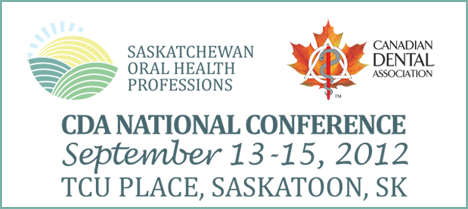
|

A member service that keeps you up-to-date on important new literature relevant to your practice.

|
|
In this final JCDA Express installment for 2011, JCDA has once again partnered with members of the graduate prosthodontics and periodontology programs at the University of Toronto faculty of dentistry. Under the guidance of department heads Dr. Asbjørn Jokstad and Dr. Jim Lai, these U of T residents provide their critical appraisal of recent articles of interest in the prosthodontics and periodontology literature.
In the coming year, JCDA will be exploring similar partnerships with other faculties and organizations—all in an effort to bring dentists clinical and scientific material relevant to your practice.
JCDA would like to gratefully acknowledge the publishers of the selected articles, who have granted free access to the full-text papers until January 21, 2012. Follow the links in the Notes and News sidebar to discover more about these publications.
The goal of JCDA Express is to provide dentists with summaries of credible, up-to-date and clinically significant information from the dental and biomedical literature. If you have encountered specific clinical problems that require solutions, please send me your suggestions for future JCDA Express topics.
I wish you all a happy holiday season and new year.
Yours sincerely,
Dr. John P. O'Keefe
Editor-in-chief
jokeefe@cda-adc.ca
|
|
|



The following 6 articles were edited and critically appraised by Dr. Asbjørn Jokstad and the residents of the University of Toronto graduate prosthodontics and periodontology programs.

|
|
|

Dr. Anne Gussgard, a member of the University of Toronto graduate periodontology program, selected:
Jönsson B, Őhrn K, Lindberg P, Oscarson N. Evaluation of an individually tailored oral health educational programme on periodontal health. J Clin Periodontol. 2010;37:912-9.
Full-text access to this article has expired.
JCDA Clinical Pearl:
-
Individualized oral health education programs for patients requiring non-surgical periodontal treatment may result in better periodontal health by empowering patients to take more responsibility for their own oral health.
What is the main clinical question addressed in the paper?
Will an oral health educational program tailored specifically for an individual influence the success of non-surgical periodontal treatment of adult patients with chronic periodontitis?
What is the current clinical “state of practice” or “state of understanding”?
Patients in need of non-surgical scaling are usually provided with a standard oral health educational program, not one designed specifically for them.
Why is it important for the clinical question to be answered?
If patients receive individually tailored education, they may require less maintenance in the future. Patients should be encouraged to take more responsibility for their own oral hygiene and periodontal health.
What is the main conclusion of the paper?
More individuals who received tailored oral health educational programs reached a level of non-surgical treatment success.
What is your assessment of the quality of the paper and the underlying evidence?
This parallel randomized controlled trial had over 100 participants for an observation period of 1 year. All patients received supportive maintenance every third month and this factor may have influenced the treatment outcome. This article should be read in conjunction with a supplementary paper1 that provides additional information about the study.
What should a clinician take away from the study findings, in terms of potential impact on clinical practice?
Providing a more individualized oral health education program to patients in need of non-surgical periodontal treatment may result in better periodontal health by empowering patients to take more responsibility for their own oral health.
Reference
-
Jönsson B, Ohrn K, Oscarson N, Lindberg P. The effectiveness of an individually tailored oral health educational programme on oral hygiene behaviour in patients with periodontal disease: a blinded randomized-controlled clinical trial (one-year follow-up). J Clin Periodontol. 2009;36:1025-34.
|
|

|
|
|

Dr. Babak Shokati, a member of the University of Toronto graduate prosthodontics program, selected:
Sailer I, Gottnerb J, Kanelb S, Hammerle CH. Randomized controlled clinical trial of zirconia-ceramic and metal-ceramic posterior fixed dental prostheses: a 3-year follow-up. Int J Prosthodont. 2009;22:553-60.
Full-text access to this article has expired.
JCDA Clinical Pearl:
-
Three-year clinical outcomes of posterior zirconia framework fixed dental prostheses (FDPs) are comparable to metal framework FDPs. However, slightly more technical and biologic complications were observed in zirconia framework FDPs.
What is the main clinical question addressed in the paper?
How do the survival rates and technical and biologic outcomes of posterior FDPs with a zirconia framework compare to posterior FDPs with a metal framework?
What is the current clinical “state of practice” or “state of understanding”?
Metal frameworks veneered with tooth-coloured ceramics still represent the standard material choice for FDPs.
Why is it important for the clinical question to be answered?
Although zirconia FDPs offer better esthetics, their load bearing capacity may be questionable. More clinical studies are needed comparing zirconia-ceramic and metal-ceramic restorations.
What is the main conclusion of the paper?
Three-year clinical outcomes of posterior zirconia framework FDPs are comparable to metal framework FDPs. However, slightly more technical and biologic complications were observed in zirconia framework FDPs.
What is your assessment of the quality of the paper and the underlying evidence?
This randomized controlled trial had a clear hypothesis, a fair sample size, used standardized prosthodontics procedures, and gave an adequate explanation for cases lost during follow-up. One potential limitation is that it used an early software version of Computer Aided Manufacture (CAM) procedure which may have led to a higher rate of unacceptable margin adaptability in zirconia-ceramic restorations.
What should a clinician take away from the study findings, in terms of potential impact on clinical practice?
Although 3-year follow-up results are promising, a lack of stress relief in zirconia frameworks may lead to a higher rate of technical and biologic complications compared to metal-ceramic restorations. Patient selection is still crucial when choosing zirconia-based frameworks over conventional metal-ceramic posterior bridges.
|
|
 |
|
|

Dr. Mohammed Zahran, a member of the University of Toronto graduate prosthodontics program, selected:
List T, Axelsson S. Management of temporomandibular disorders: evidence from systematic reviews and meta-analyses. J Oral Rehabil.2010;37:430-51.
Full-text access to this article has expired.
JCDA Clinical Pearl:
-
There is some evidence that occlusal appliances, acupuncture, behavioural therapy, jaw exercises, postural training and certain pharmacological treatments can be effective in alleviating temporomandibular disorder pain.
What is the main clinical question addressed in the paper?
What is the efficacy of different modalities used to manage temporomandibular disorders (TMDs)?
What is the current clinical “state of practice” or “state of understanding”?
A wide variety of treatment modalities are utilized to manage TMDs. This systematic review synthesized recent evidence and assessed the methodological quality of published systematic reviews regarding the management of TMDs.
Why is it important for the clinical question to be answered?
It is beneficial to update, summarize and assess the evidence supporting different TMD treatment modalities.
What is the main conclusion of the paper?
There is some evidence that occlusal appliances, acupuncture, behavioural therapy, jaw exercises, postural training, and certain pharmacological treatments can be effective in alleviating TMD pain. However, the evidence for the effect of electrophysical modalities and surgery is insufficient while occlusal adjustment seems to have no effect.
What is your assessment of the quality of the paper and the underlying evidence?
This systematic review utilized an extensive methodology to summarize and assess the quality of evidence gathered from other reviews and meta-analyses.
What should a clinician take away from the study findings, in terms of potential impact on clinical practice?
The results generated from this study could help clinicians by supporting or modifying his/her current approach to managing TMDs.
|
|
 |
|
|

Dr. Joseph Fava, a member of the University of Toronto graduate prosthodontics program, selected:
Nakamura K, Kanno T, Milleding P, Ortengren U. Zirconia as a dental implant abutment material: a systematic review. Int J Prosthodont. 2010;23:299-309.
Full-text access to this article has expired.
JCDA Clinical Pearl:
-
Zirconia abutments seem comparable to titanium or alumina abutments in the short term, but they should be used with caution and only for single implant supported restorations in the esthetic zone.
What is the main clinical question addressed in the paper?
How do zirconia dental implant abutments compare to other materials in terms of esthetics or potential for biological and technical complications.
What is the current clinical “state of practice” or “state of understanding”?
Zirconia abutments are used for improved esthetics. However, the long-term success or survival rates and occurrences of complications have not been determined.
Why is it important for the clinical question to be answered?
Dentists occasionally have to restore an implant that was poorly placed in the esthetic zone. Zirconia abutments are used to optimize esthetics, but there is limited evidence on their long-term efficacy.
What is the main conclusion of the paper?
This systematic review concludes that at present, zirconia abutments should be used with caution and only for single implant supported restorations in the esthetic zone. Zirconia abutments seem to be comparable to titanium or alumina abutments in terms of mechanical and biologic properties in the short term.
What should a clinician take away from the study findings, in terms of potential impact on clinical practice?
The prudent practitioner should only recommend zirconia abutments in patients with high esthetic demands to avoid potential long-term biological and technical complications.
|


Dr. Joseph Fava, a member of the University of Toronto graduate prosthodontics program, also selected:
Chen ST, Buser D. Clinical and esthetic outcomes of implants placed in postextraction sites. Int J Oral Maxillofac Implants. 2009;(24 Suppl):186-217.
Full-text access to this article has expired.
JCDA Clinical Pearl:
-
In patients with a history of chronic periodontitis it is prudent to wait until the soft tissues have healed post extraction prior to placing implants.
What is the main clinical question addressed in the paper?
When is the optimal time to place implants in post extraction sites? Will patients benefit from having implants placed immediately post extraction or delayed, in terms of incidence of peri-implant defects, implant survival and success and esthetic outcomes.
What is the current clinical “state of practice” or “state of understanding”?
There is no clear consensus or guideline about the optimal time for implants to be placed post extraction.
Why is it important for the clinical question to be answered?
Dentists are often presented with the clinical situation where a tooth is to be extracted and an implant-supported fixed prosthesis is part of the treatment plan.
What is the main conclusion of the paper?
Within the limitations of this systematic review, it appears that immediate placement does not prevent vertical or horizontal resorption of the ridges. Also, a history of chronic periodontitis is a risk factor for survival of postextraction implants and gingival recession is common with immediate placement.
What should a clinician take away from the study findings, in terms of potential impact on clinical practice?
Although it is believed that implants should be placed immediately post extraction to prevent vertical or horizontal resorption of the ridges, it would be prudent to wait until the soft tissues have healed post extraction prior to placing implants to have a more predictable result—especially in patients with a history of chronic periodontitis.
|


Dr. Herman Thang, a member of the University of Toronto graduate periodontology program, selected:
Darby I, Chen ST, Buser D. Ridge preservation techniques for implant therapy. Int J Oral Maxillofac Implants. 2009;(24 Suppl):260-71.
Full-text access to this article has expired.
JCDA Clinical Pearl:
-
Patients with a history of periodontitis may be at a higher risk for adverse outcomes, such as increased peri-implant marginal bone loss and implant failure, following implant therapies.
What is the main clinical question addressed in the paper?
To summarize the consensus statements and clinical recommendations from the Fourth International Team for Implantology (ITI) consensus conference regarding surgical techniques and the use of biomaterials in implant dentistry, specifically for the use in extraction sites, bone augmentation in localized and extended defects and ridge augmentation.
What is the current clinical “state of practice” or “state of understanding”?
A wide variety of procedures and biomaterials are being introduced and utilized in implant therapy. There is a need for up-to-date consensus statements that review and summarize the latest research for clinicians.
Why is it important for the clinical question to be answered?
Difficulties and confusion exist in assessing, evaluating and selecting the appropriate surgical technique and biomaterials for bone augmentation procedures.
What is the main conclusion of the paper?
Primary stability regardless of the implant protocol is required. Dehiscence and horizontal ridge defects can be grafted predictably, however vertical defects demonstrated elevated rates of complications. Few studies are available to directly compare various techniques. However, implants placed in bone augmented with distraction osteogenesis, and le Fort I osteotomies have reported lower survival rates
What is your assessment of the quality of the paper and the underlying evidence?
This is a succinct, direct and clinically relevant review of various surgical techniques. It offers a brief summary of an extremely wide body of research. Limitations of the article include having no study design or descriptions and comparison of the included studies. Also, there was no meta-analysis, pooling of data or statistical evaluations performed.
What should a clinician take away from the study findings, in terms of potential impact on clinical practice?
Several techniques are available to achieve bone augmentation in implant therapy, each with a variety of risk and morbidity, which must be cautiously evaluated on a site- and case-specific basis.
|


|
|
|
|
|

JCDA is the authoritative written voice of the Canadian Dental Association, providing dialogue between the national association and the dental community. It is dedicated to publishing worthy scientific and clinical articles and informing dentists of issues significant to the profession.

|
|
|



